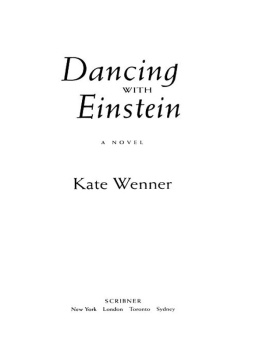Also by Kate Wenner
Setting Fires
Shamba Letu: An American Girl's Adventure in Africa

SCRIBNER
1230 Avenue of the Americas
New York, NY 10020
This book is a work of fiction. Any reference to historical events, real people, or real locales is used fictitiously. Other names, characters, places, and incidents are products of the authors imagination, and any resemblance to actual events or locales or persons, living or dead, is entirely coincidental.
Copyright 2004 by Kate Wenner
All rights reserved, including the right of reproduction in whole or in part in any form.
SCRIBNER and design are trademarks of Macmillan Library Reference USA, Inc., used under license by Simon & Schuster, the publisher of this work.
Library of Congress Cataloging-in-Publication Data is available.
Wenner, Kate.
Dancing with Einstein: a novel/Kate Wenner.
p. cm.
1. Nuclear warfarePsychological aspectsFiction. 2. ScientistsFamily relationshipsFiction. 3. Fathers and daughtersFiction. 4. Atomic bombFiction. 5. GirlsFiction. 6. WomenFiction.
I. Title.
PS3573.E55D36 2004
813 .54dc22
.54dc22
2003065681
ISBN-13: 978-1-4165-8544-2
ISBN-10: 1-4165-8544-3
The Peace of Wild Things is from The Selected Poems of Wendell Berry by Wendell Berry.
Copyright 1998 by Wendell Berry. Reprinted by permission of Counterpoint Press, a member of Perseus Books, L.L.C.
Our Whole Life. Copyright 1993 by Adrienne Rich. Copyright 1971 by W. W. Norton & Company, Inc., from Collected Early Poems: 1950-1970 by Adrienne Rich.
Used by permission of W. W. Norton & Company, Inc.
For Gil, Jake, and Sophie,
the treasures of my life
The Peace of Wild Things
When despair for the world grows in me
and I wake in the middle of the night at the least sound
in fear of what my life and my childrens lives may be,
I go and lie down where the wood drake
rests his beauty on the water, and the great heron feeds.
I come into the peace of wild things
who do not tax their lives with forethought
of grief. I come into the presence of still water.
And I feel above me the day-blind stars
waiting for their light. For a time
I rest in the grace of the world, and am free.
W ENDELL B ERRY
Dancing
WITH
Einstein
1
It begins between the thoughts of Marea. Marea, named for the dark seas of the moon. It begins with the token it takes to enter the subway station beneath Union Square, where a solitary woman stands by the tracks, waiting for the trains to cross in front of her. She is waiting for the moment when two passing trains line up so perfectly that she can see through their windows to the other side. It doesnt always happen. It depends on coincidence, timing, and luck. It depends on one train traveling north and another traveling south, crossing at the platform at just the right speed. Sometimes there is so much screeching and banging of metal wheels that it can be difficult to discern the direction from which the trains are actually coming. Marea is keyed up, but patient. Hope rises in her chest when a second train appears. She smiles as the north- and southbound trains begin to cross, their windows shuffling like a deck of cards. Heads blur, gestures drift, and the row of opened newspapers flows into a radiant ribbon of white light.
When the northbound train comes to a stop in the station, Marea steps in to take a seat and opens her subway map to check her destination. She traces the Lexington line and then runs her finger along the other routes, the Broadway local, the A, B, and D, the L traversing Fourteenth Street, the RR, the NN, all weaving over and around each other like brightly colored neon piping, the urban arteries. Marea is happy to enter the map, to enter the world of the subway. She learned very early as a child at a school desk that maps can replace the territories for which they stand. Maps can substitute for places, as travel can substitute for life.
The subway car swaying north rocks Marea into a childhood memory of maps. The immense and imperious Miss Pearl wielded her wooden yardstick like a scepter, whacking it against her huge palm, the slap of flesh curdling the stomachs of the children who sat before her waiting for the promised land of morning recess. The days lesson was about Pharaohs inbreeding to make morons, Chinese babies preposterously crowned as emperors, Indian children of a caste so vile they could not be touched. Miss Pearl hauled her massive body around the classroom, her chin melting into her neck, her neck sloping into the Matterhorn of her undulating flesh. Sweat made moons below her armpits, and the odor curled nostrils as she handed out tracing paper and boxes of crayonsemerald green to color in the Fertile Crescent, cerulean blue for the Mediterranean Sea, burnt umber for the deserts of Egypt. When Miss Pearls fleshy hip saddlebagged over the Formica of Mareas desktop, Marea withdrew into the safe territory where her crayoned map replaced the living world.
The lesson in maps, the lesson of one thing standing for another, came in handy on the day Miss Pearl ushered in our very important visitor from the department of civilian emergencies. A short beetle man with a black pompadour, dark blue suit, and shoes planted like duck feet had brought his own map and climbed up onto a chair to hang it from the hooks above the blackboard. He climbed back down and borrowed Miss Pearls yardstick to give the third-grade class its instructions for survival. Marea saw that he was uncomfortable with his task of confronting children, and she smiled at him to help ease his pain.
The beetle man settled down to his responsibilities. On his map of the United States he stuck large black plastic dots over each of the major cities from Washington, D.C., to San Francisco. He used Miss Pearls yardstick to count them off in the order the Russians would destroy them. Then he took a black crayon and drew five concentric circles around each of the targeted East Coast cities. The concentric circles around New York and Washington, D.C., intersected at Princeton, New Jersey, where Marea and her classmates listened silently to the mans grim prediction.
Concentric Circle One would be a huge crater into which all of New York City would disappear before a bird had time to flap its wings. In Concentric Circle Two bodies would melt like ice cream left in the summer sun. In Concentric Circle Three gases would fill lungs with death-breath and people would collapse like rag dolls without bones, and the only hope for life would be to flee in station wagons to Concentric Circles Four and Five. Cars would line up outside Abraham Lincoln Elementary, and good children would be brave and never cry or think about melting mothers and fathers. One by one the station wagons would fill and begin the drive into the western mountains, where children would be given shelter and new parents and, God willing, be saved.
During air-raid drills Miss Pearl stood at the front of the room with her arms folded across her vast breasts. When we go outside, you will line up nicely, children, even if there is an atomic bomb.
At home Marea kept the lesson of the concentric circles to herself. Her parents fought. Did all parents fight? Maybe, but not all fathers made bombs big enough to blow up the world. Each time her father left to work with Dr. Teller in New Mexico, Marea could hear her mothers crying through the walls at night. Marea wanted to tell her mother how lonely it felt when she got under her school desk to practice for nuclear war, but she knew her mother would blame her father. Her parents argued so much that Marea worried that one day her father might leave forever.














 .54dc22
.54dc22